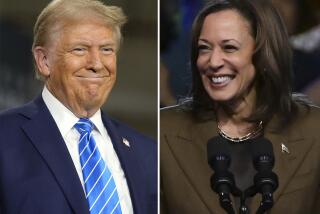Democrats aim for a Senate majority, and the polling looks favorable

WASHINGTON — As Republicans inch closer to confirming Amy Coney Barrett to the Supreme Court, and Joe Biden enjoys a national lead over Donald Trump in the presidential race, there’s also an intense battle going on for control of Congress.
The 2016 election delivered Republicans the White House in addition to both chambers of Congress. Democrats turned that around partway as they rode a wave of discontent to flip the House of Representatives in 2018.
Now, liberals are looking to extend that momentum and take full control of Congress by regaining control of the Senate. Paired with a Biden win, turning the Senate blue would give Democrats free rein to pass legislation (although the Supreme Court, especially with Barrett on it, could still challenge the constitutionality of their achievements). Conservatives nervous about a Trump loss are hoping to maintain control of the Senate as a bulwark against a carte blanche Democrat agenda.
The chamber’s current breakdown finds Republicans with 53 seats and Democrats with 47. Flipping four seats in November would give Democrats control. If Biden wins, a Vice President Kamala Harris could break ties, lowering the threshold to three new seats.
Where might those seats come from? And are Democrats at risk of losing any of their own? Recent polling offers some insight.
Read more about some of the most contentious Senate seats here.
In Arizona, Republican incumbent Sen. Martha McSally faces stiff competition from Democrat and former astronaut Mark Kelly. Only two years ago, McSally ran for and lost one of the state’s Senate seats — but was soon thereafter appointed to fill the other, which had been vacated by the death of Sen. John McCain.
Ipsos polling found Kelly ahead by 10 percentage points, 51% to 41%, in late September and early October. Data Orbital found a tighter race in early October but Kelly still ahead, at 49% to McSally’s 44%.
Colorado — which voted against Trump in 2016 — now looks poised to unseat Republican incumbent Sen. Cory Gardner. Former Gov. John Hickenlooper leads Gardner 48% to 39%, SurveyUSA found.
“Hickenlooper’s advantage comes predominantly from Hispanic voters, where he leads by 27 points,” the polling firm notes.
Both of Georgia’s Senate seats are up for grabs, and both are currently held by Republicans. Sen. David Perdue faces a regular election. Sen. Kelly Loeffler, who was appointed by Georgia’s governor in December to finish the term of her retiring predecessor, is now running in a special election per state law.
Georgia law mandates a runoff if no candidate hits 50%, and Public Policy Polling suggests both races are headed for just that. In the regular election, Perdue is down by 1 point to Democrat Jon Ossoff, 43% to 44%, with Libertarian Shane Hazel taking 4%. In the special election, the Rev. Raphael Warnock, a Democrat, stands at 41%, while Loeffler and another Republican, Rep. Doug Collins, are at 24% and 22%, respectively.
Warnock has been endorsed by former Presidents Carter and Obama. Because Collins and Loeffler are both Republicans, Warnock would probably go into a runoff several points behind whichever of them he finds himself up against.
Iowa was at one point expected to be a safe bet for Republican incumbent Sen. Joni Ernst, but two polls now put her behind Democrat challenger Theresa Greenfield. Quinnipiac University found a 5-point Greenfield lead among likely voters, 50% to 45%, with a 2.8-point margin of error. CBS News and YouGov found a similar gap, Greenfield 47% and Ernst 43%, but among registered voters and with a 3.5-point margin.
No new major public polls have come out of Maine in the last couple of weeks, but the race between center-right incumbent Sen. Susan Collins and liberal challenger Sara Gideon remains one of Democrats’ best shots at picking up a new seat.
Mid-September polling by Colby College gave Gideon a four-point lead as voters’ top choice (the state uses a ranked-choice system), and Suffolk University found a 5-point Gideon lead around the same time. A New York Times-Siena College poll had Gideon ahead by 5 points.
Montana is a Republican stronghold, and Emerson College polling affirms as much, giving Republican incumbent Sen. Steve Daines a 9-point lead over Democratic Gov. Steve Bullock.
But Public Policy Polling, a Democratic firm, suggests a tougher brawl, finding the candidates in a dead heat — 48% all — and with “nearly identical approval ratings.”
North Carolina’s race has proved to be one of the country’s most dramatic, with Republican incumbent Sen. Thom Tillis testing positive for the coronavirus after attending Barrett’s announcement ceremony turned possible super-spreader event. In the meantime, Democratic nominee and former state Sen. Cal Cunningham finds himself embroiled in an extramarital sexting scandal.
Public Policy Polling deemed the race “unaffected by recent developments” and identified a Cunningham lead of 48% to Tillis’ 42%, similar to late July’s Cunningham 48%-Tillis 44% split. A second poll this week, by Survey USA, found Cunningham up 49% to 39%, slightly better than his standing before the sexting scandal.
Unfortunately for Democrats, they aren’t the only ones looking to flip seats; Republicans have some options too. Even though Democrats have plenty of possibilities when it comes to flipping seats blue, the question is less how many seats they can flip blue than how many more seats they can flip blue than the Republicans can flip red.
Alabama, for instance, looks very likely to turn from blue to red. Auburn University at Montgomery recently found Republican nominee Tommy Tuberville 12 points ahead of Democratic incumbent Sen. Doug Jones, 54% to 42%. (Jones’ victory in a 2017 special election in the deep-red state is considered something of a fluke; his opponent, Roy Moore, faced allegations of sexual assault and other misconduct, including with minors.)
In Michigan, the New York Times and Siena College found a significant tightening of the race between Democrat incumbent Sen. Gary Peters and Republican challenger John James. Peters’ single-point lead, 43% to 42%, is strikingly smaller than the 10-point one the same pollsters gave him in June.
That said, a 10-point lead in Peters’ favor is exactly what a new poll from Emerson College found — 51% Peters versus 41% James — so it’s possible that Siena’s June numbers will ultimately prove more predictive than its October ones.
A third new Michigan poll from CBS News and YouGov comes down in the middle, giving Peters a 3-point lead, 47% to James’ 44%.
Another race that appears to have tightened is in Minnesota, where Democratic incumbent Sen. Tina Smith’s lead over Republican Jason Lewis has dropped from 11 points to 7: 44% Smith, 37% Lewis, SurveyUSA reports.
Our previous reports on campaign-trail polling
Oct. 5 — Despite surprise news, a stable race with Trump behind in key states
Sep. 28 — As Biden, Trump begin debates, the races in battleground states are tight
Sep. 24 — Biden strong in red states; Collins struggling at home
July 23 — Biden leads in the polls: Could they be missing something?
More to Read
Get the L.A. Times Politics newsletter
Deeply reported insights into legislation, politics and policy from Sacramento, Washington and beyond. In your inbox three times per week.
You may occasionally receive promotional content from the Los Angeles Times.











